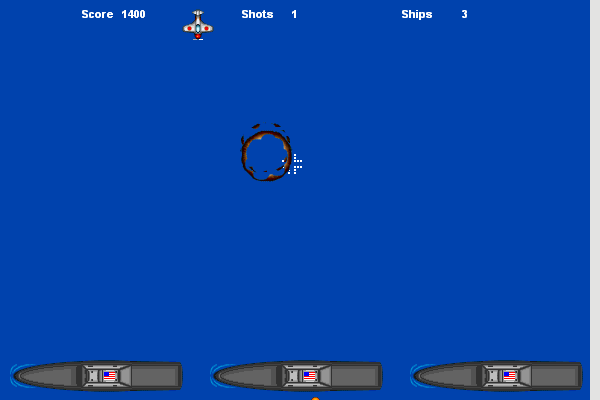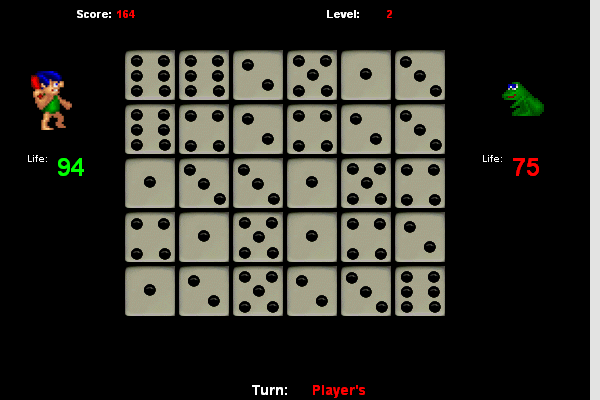Book Reviews Category
-
Learning ActionScript 3? Here are some great books
31st May 20117After publishing my review of the recent Flash Game Development by Example book (in which my complaints were validated by similar reviews from Iain and Rasmus) I received a number of questions both by email and on Twitter asking me books what I would recommend.
The first thing I’ll say is that I don’t believe there are ANY good books that teach you how to code in AS3 by using game development as the means.
There are some excellent AS3 books, and some excellent game development ones, but all those that have tried to combine the two end up either skipping vital AS3 details, or build such basic games you don’t really learn anything about game development in the process.
Before I begin however this is important: Obviously I have not read every book there is on AS3. So my recommendations here can only be based on the books I have read and value. If you’re the author of a book not listed, that you think should be, send me a review copy. Here’s my list with links to the publishers sites (and no cheesy affiliate links!)
Learning ActionScript 3 by Rich Shupe, O’Reilly
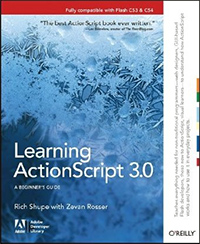 I strongly suggest the excellent “Learning ActionScript 3.0” by Rich Shupe and Zevan Rosser. Even if you’ve been coding in AS3 for a while there are things this book can teach you. It leaves virtually no stone unturned. Read this from cover to cover and you will have touched on every aspect of AS3 you need. From the way events propagate, to text handling, bitmap filters and display list management it’s comprehensive and clearly written. The only issue is that the contents are a bit dry. By this I mean you’ll never actually create anything fun while reading this, and you won’t learn a thing about game structure. But to sink your teeth into AS3 they don’t come much better than this. The 2nd edition was published at the end of 2010 incorporating Flash platform changes that entails, so if you do seek out a 2nd hand copy, make sure it’s a recent one.
I strongly suggest the excellent “Learning ActionScript 3.0” by Rich Shupe and Zevan Rosser. Even if you’ve been coding in AS3 for a while there are things this book can teach you. It leaves virtually no stone unturned. Read this from cover to cover and you will have touched on every aspect of AS3 you need. From the way events propagate, to text handling, bitmap filters and display list management it’s comprehensive and clearly written. The only issue is that the contents are a bit dry. By this I mean you’ll never actually create anything fun while reading this, and you won’t learn a thing about game structure. But to sink your teeth into AS3 they don’t come much better than this. The 2nd edition was published at the end of 2010 incorporating Flash platform changes that entails, so if you do seek out a 2nd hand copy, make sure it’s a recent one.I used to recommend Essential ActionScript 3 by Colin Moock (also by O’Reilly) but the freshness of content in this book kicks it one level higher.
http://oreilly.com/catalog/0636920010401
ActionScript 3.0 Cookbook, O’Reilly
I’m a big fan of the O’Reilly cookbooks. They come into their own when you’re starting to learn a language and have the basics down – but just need to know in which package to look to find the solution to a given problem. For example if you want to know how to load an XML file you can just pick-up the cookbook and look for that in the index. The code examples are concise and well written, and coming from a variety of authors seems to help make them more relevant. It’s a really vital book. Yes you can Google, but if you are learning a language there is no way for you to evaluate how well written (or correct!) a Googled blog post is for example. The only issue I have with this book is that it hasn’t been updated since 2008. It was however the way I learnt AS3 (used with the Essential AS3 book).
http://oreilly.com/catalog/9780596526955
Foundation ActionScript 3 Animation: Making Things Move! by Keith Peters, Friends of Ed
 This is a brilliant book. There’s no other way to put it. It starts off with a great crash course in AS3 (take note authors, this is the correct way to do it) and then dives in to, well.. making things move! Making them properly move. None of this Flash IDE timeline stuff, but actual real physics that you can use in real games. And it’s not complicated physics either. It starts off very gently and then keeps layering it up. Bouncing, friction, gravity, velocity. Throwing objects with the mouse, collision, springs, the works. There is even a little chapter on faux 3D (which to be honest feels shoe-horned in, and isn’t very relevant today). You will learn both good structured AS3 AND very useful game development techniques from this book, which is why it’s essential reading. The only down side is that it hasn’t been updated for a while. There is a follow-up book (Advanced Animation) but it’s not as easy to get in to and feels a little more “edge case” in its application. Still a fascinating read though.
This is a brilliant book. There’s no other way to put it. It starts off with a great crash course in AS3 (take note authors, this is the correct way to do it) and then dives in to, well.. making things move! Making them properly move. None of this Flash IDE timeline stuff, but actual real physics that you can use in real games. And it’s not complicated physics either. It starts off very gently and then keeps layering it up. Bouncing, friction, gravity, velocity. Throwing objects with the mouse, collision, springs, the works. There is even a little chapter on faux 3D (which to be honest feels shoe-horned in, and isn’t very relevant today). You will learn both good structured AS3 AND very useful game development techniques from this book, which is why it’s essential reading. The only down side is that it hasn’t been updated for a while. There is a follow-up book (Advanced Animation) but it’s not as easy to get in to and feels a little more “edge case” in its application. Still a fascinating read though.http://www.friendsofed.com/book.html?isbn=1590597915
With the above 3 books I honestly believe you can go from knowing nothing at all about AS3, to having touched all the important aspects of it, and even built some really cool things in the process. Use them in combination with a framework like Flixel and suddenly a LOT of the way Flixel does things will make a great deal more sense to you. Equally if you stumble across a piece of source code online you’ll have a much better idea if you’re looking at quality code or a piece of blog filler.
Advanced ActionScript 3 with Design Patterns by Joey Lott, Adobe Press
This was recommend by both Iain Lobb and Damien Altron. Be sure you get the correct book as there is a very similar titled book published by O’Reilly. The one you want is published by Adobe Press. The first half deals with general AS3 practises and the second half the use of design patterns. From the comments I’ve read it appears it’s very well researched and written.
http://www.amazon.co.uk/Advanced-Actionscript-3-Design-Patterns/dp/0321426568
I will follow-up this post with one listing my favourite AS3 Game Development books shortly. But really, get the language down first. Then make games. Not the other way around.
-
Flash Game Development by Example Book Review
25th May 2011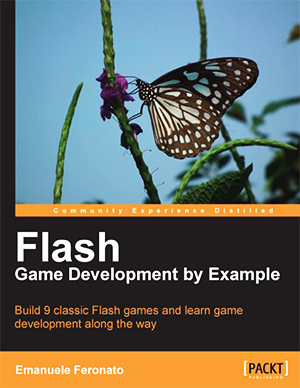 Emanuele Feronato is a familiar name to anyone who’s ever searched for something to do with Flash game development on Google. The tutorials he publishes on his blog are as ubiquitous as the platform itself. They provide nuggets of code usually meaty enough to accomplish the task at hand. Be it creating a Match-3 knock-off, a landscape generator or showcasing a new library. The complexity never really leaves the shallow end of the pool, which I suspect is the main reason beginners flock to his site.
Emanuele Feronato is a familiar name to anyone who’s ever searched for something to do with Flash game development on Google. The tutorials he publishes on his blog are as ubiquitous as the platform itself. They provide nuggets of code usually meaty enough to accomplish the task at hand. Be it creating a Match-3 knock-off, a landscape generator or showcasing a new library. The complexity never really leaves the shallow end of the pool, which I suspect is the main reason beginners flock to his site.But with a book you leave the safety zone of “this is just enough” behind. When people have put down good money, the expectation levels are rightly higher. So it was with intrigue that I started reading Flash Game Development by Example. It covers the creation of 9 games across 300+ pages, which is an average of 30 pages each. Probably 28 more than he uses on his web site 🙂 I was curious what this extra space would provide.
The first game we make is Concentration or “Pairs”, the classic card game. Everything is done in the Flash IDE at a size of 550 x 400, and it leads you step-by-step through creating an FLA, creating your Main.as, entering a trace statement to prove it compiles and then explaining what imports and packages are. The explanation for the Sprite package for example is “This class allows us to display graphics”. That’s true, and while I’m not expecting a detailed explanation at this level I did expect a little more. Emanuele then starts creating the game, kicking off with a loop to make an Array of 20 tiles. Every single line of code is explained – rapidly jumping through AS3 syntax as it goes. It’s as if the single line of source “for (var i:uint=0; i<NUMBER_OF_TILES; i++)” caused Emanuele to stop and realise he had better explain what a uint, a constant and a for loop is before he can carry on.
The problem with this approach is you forget what it was you were building as you try to deal with a rapid onslaught of new information. And it doesn’t let-up. By page 19 the game is dealing with adding a Fisher-Yates shuffle algorithm. A quick trip back to the Flash IDE creates some tiles, and more code starts displaying them and adding event listeners for clicks. By page 31 you’re deep in the realm of indexOf Array checks, event.currentTarget magic value access and modulo operations. Nearly every line of code is still being explained but the pace is borderline frantic. And just like that, it ends. The game is complete, a few homework assignments are given to you and we’re on to Chapter 2.
Chapter 2 is about building Minesweeper. So multi-dimensional arrays and iterative scanning for mines. It also contains probably my favourite quote in the whole book:
“Just think about a function like a mad witch. You give her some strange stuff such as bat wings and lizard tails, and after making something mysterious she gives you a potion to turn someone into a frog. The great thing is once you’ve made your functions (witch) you don’t need to know how they do the magic anymore.”
🙂
However this is a bit of code taken from the function it teaches you to make:
Read More -
Getting Your Flash Game Sponsored – Book Review
1st Nov 2010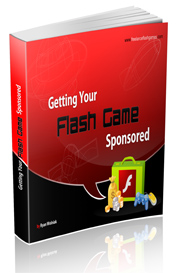 Ryan Wolniak, fellow Flash game dev and owner of the popular freelanceflashgames.com was kind enough to send me a copy of his new book: Getting Your Flash Game Sponsored. This is a self-published title available to buy from his site for $20 in PDF form, or $30 as a paperback.
Ryan Wolniak, fellow Flash game dev and owner of the popular freelanceflashgames.com was kind enough to send me a copy of his new book: Getting Your Flash Game Sponsored. This is a self-published title available to buy from his site for $20 in PDF form, or $30 as a paperback.I felt it only fair that I should give the book a detailed but balanced review. So after reading it all that is what I present here …
The contents of this book start with “What is Sponsorship?” and cover a decent range of subjects from uploading to FGL, making your game “appealing”, dealing with the bidding process through to sale. There are over 160 pages of content, although depending on your experience as a developer some of them could be seen as filler.
It kicks off with the most important aspect of all – the variety of sponsorship offers out there, and the terminology that goes with it. Exclusive, Primary, Site-locked, Performance Bonuses, etc. It does a good job of giving the basics for each type although I did smile at the comment that “site-lock” sales usually are not “that much work” because you just switch out branding and drop in a new API. I’m sure I am not alone when I say that I’ve seen some portal APIs that would make you truly weep! And you should never under-estimate how long some API work can take. It’s not uncommon for the more complex ones to be a good evenings work (3+ hours). On the flip-side I do find that the most complex APIs come from the portals who pay the most.
I like the fact that Ryan mentions the selling of Source Code, although I didn’t agree with the statement that “You lose all rights to your game”. That is entirely specific to the deal you are making. I’ve sold the source code to a couple of my games, and both times they bought the rights to re-brand it for a single-use game and nothing more. It was an easy way to make a decent amount of money, although I know a number of developers who wouldn’t part with their code for all the tea in China.
There are some interesting stats in the Game Details section. Here we are told about the importance of naming our game well. The stats show how many words are optimal in your game title across both Kongregate and Newgrounds. The only issue I had was that the pie chart segments were all in very similar shades of blue making them hard to read. As you can imagine most games have between 1-3 words in their title. This chapter continues to explain the right way to handle thumbnails, game screen shots, your game description and then dives out into an 11 page tangent on video capture and production (should you wish to make your own game trailer). I honestly feel it would have been better to insert good examples of thumb nails, screen shots and really captivating game descriptions instead.
The Upload Process is essentially a guide to using the Flash Game License web site. There’s nothing wrong with this section, and it could be of help to newbies or younger developers. But I can’t help shake the feeling that if you’ve got to the point of being capable of coding your own game, then you’re almost certainly capable of filling out an upload form. Having said that it does help steer you through the jargon minefield you’ll encounter on the way.
The next chapter is on the importance of getting Feedback on your game. Again this is mostly about how to achieve this via FGL and using their First Impressions service. Both things I’d suggest you do. Although First Impressions are very hit and miss, they nearly always carry a core element of truth to them. Once you’ve collected your feedback it makes sense to improve your game based upon it, and there’s a chapter dedicated to doing exactly that. This walks you through improving everything from your main menu, to your instructions process (how you educate the player), to audio, highscores, upgrades and achievements. This is a big section. And for the most part it’s a really good one, especially for new developers.
On page 121 we hit the “Start the Bidding” process. Arguably the most important part of the book. It contains a lot of information direct from the guys who run Flash Game License, by way of lots of quotes about how their process works. This is useful stuff, and gives you a little insight into what’s going on behind the web site itself. There’s a huge section on dealing with emailing sponsors, how to talk to them, negotiation and managing your relationship.
I very much liked the fact that Ryan makes it clear that sponsors are “just people too” as this is bang-on. But I wish he’d expanded this section a bit to include “How to deal with asshole sponsors”. If you are being offered a duff deal, don’t take it. Walk away. If a sponsor is offering you grief via a horrendous API, or taking ages to process a payment, don’t be scared of making this known to them. While I agree that you should remain professional, you should never be made to feel intimidated. I once had a sponsor successfully win the bid on one of my games, only to email me a few days later saying “We’ve realised there is only one level in the game. Can you add some more?” – I was extremely annoyed because it clearly said the game had one level (that was actually the whole point of the game), and more importantly they were requesting something well beyond the price they’d paid for it. So I said “no”. All I can say is don’t let them take the piss – if a sponsor starts asking for changes to your game, or offering creative advice, don’t be scared of reminding them they aren’t the game designer – you are – and they sponsored the game in the state it was shown on FGL, and additional work will be charged for.
There’s a really nice Case Study from Bezerk Studios. Certainly one of the most successful Flash game development team working at the moment, it was really interesting to read about how they are constantly pitting bidders against each other. They demonstrate clearly that even after you’ve done everything this book recommends, and have tweaked your game to perfection, the best deals come down to constant negotiating and haggling, and that in itself is a fine art.
I’m in a mixed mind over the book. Ryan has done a sterling amount of work, collecting together helpful quotes and opinions from developers and sponsors alike. He’s covered all of the core areas of game sponsorship, if a little briefly in some places, and it’s written in a good conversational tone without making too many outlandish claims. However if you’ve already sold a game on FGL then there is probably very little you will read that hasn’t occurred to you already. If you are extremely new to the process, then it covers some solid ground in a decent amount of depth. At the end of the day only you will know if the book is worth your time or not, and there is always the “30 day money back guarantee” on the PDF version, which is a rare and brave thing to offer. I feel there are several sections that could have been added to this book, and some which it wouldn’t hurt from dropping. But as a self-published first attempt I can’t fault the enthusiasm on display here.
Getting Your Flash Game Sponsored is available from http://freelanceflashgames.com/getting-your-flash-game-sponsored/ (and yes I know the layout and copy on this page reads like one of those “Get Rich Quick” schemes – “I learned from their mistakes so you don’t have to!” (ick) but thankfully the copy of the book itself is far more approachable! So don’t let it put you off)
-
The Essential Guide to Flash Games: Book Review
6th Sep 2010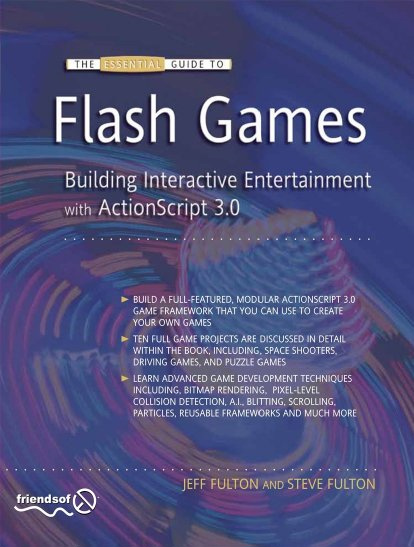 Update: For a 25% off Discount code read to the end!
Update: For a 25% off Discount code read to the end!For the sake of transparency I just want to state: Friends of Ed offered me a free copy of this book for the purpose of reviewing it. However I declined as I had already pre-ordered my copy from Amazon, as I’m a great fan and friends with the authors Jeff and Steve Fulton. That doesn’t mean I’m going to treat this book with kid gloves or sugar coat my review however.
Dissecting a mammoth
Jeff and Steve Fulton, the pair responsible for the ever popular 8-bit Rocket web site, home to many tutorials on Flash game development, decided to combine their collective knowledge into one single tome. And this is the end result.
The book is split over 12 chapters which make up the majority of its 630+ pages. The chapters are split into two parts: Basic Game Framework and Building Games. It kicks off by going through their “Second Game Theory” which basically says your first game will always be utter tripe, and things only really start getting interesting from your second game and onwards (or if you are like me, your 10th game onwards). But it does cover some basic concepts such as proper object-orientated coding, but always in a game context. That is what I like most about this book, every snippet of information relates to making games, not some random computer science terminology you’ll never care about or commit to memory.
It then dives head first into building a game framework, including a solid and re-usable state machine, game timer and event model. By page 15 you have finished coding your first game, and while it’s a simple click counter it all runs from a well defined framework that is re-used and expanded upon throughout the rest of the book.
The second game is “Balloon Saw” in which you control a spinning blade with the mouse, and must take out as many floating balloons as possible. Again it’s simple, but it introduced more important new concepts: level progression, player controls, collision detection and scoring. By page 30 it’s all over, the lessons are learnt, you’ve another game under your belt and they waste no time in jumping into the 3rd game: Pixel Shooter.
Once Pixel Shooter is over you’ve got a complete space invaders style game finished, and more importantly they don’t dwell on every aspect of it – but only those aspects that differ from the previous game. I’m a big fan of learning through iterations, and that is certainly how this book approaches things.
Once you hit Chapter 2 it’s all about strengthening the framework you’ve already put in place. They add lots of powerful new features such as Custom Events handlers, a Basic Screen handler, Buttons and a Score Board (which is more the in-game UI for scores, not a Mochi Leaderboard type affair). Several pages are dedicated to the package structure, creating the game stub (which is done via FlashDevelop) and just setting your project up in a nice and clean way. Again I’m a big fan of this approach, and I have my own “template” project structure that I roll-out for all new games I write which matches theirs very closely. You don’t have to follow their structure to the letter (although it would be useful if following all of their game builds in the book), but by all means take from it the parts you find most useful, and settle on what works best for you. But the final message is the same: don’t be messy.
By page 100 the framework is in place. This is quite a hard-going chapter, and while vital for the rest of the book I can see a lot of developers getting that glazed look in their eye as they pour through page after page of class set-up and variable declarations. As important as it is I can’t help but feel that it may have been better to keep up the earlier frenetic pace of game building, and drip-fed more of the framework in the same manner.
Once the framework is in place Chapter 3 creates the “Super Click” game, an iteration of the very first game made in the book. It starts off by getting the reader to create a really brief game design document. All it asks you to do is write a very short snippet about what the game is, and define the basics such as the name, the objective, a description of play and creating a list of required assets/logic/variables.
It may seem long-winded to be doing this for such a simple game, most of which you argue you could just “remember” rather than write down. But GDDs are a tried and tested practise found in the industry. Any game developer I have working in my team will all have to write GDDs before they touch a line of code, and Jeff and Steve are the same. So if you plan on making Flash games as a “pro”, don’t skip this part.
Taking some Flak
As you may expect by now Chapter 4 is all about creating yet another game. This time a homage to Missile Command only with boats and planes. Jeff and Steve are children of the 80s and the Atari blood runs deep through their veins. You’ll see this scattered through-out the book, not least of which is a whole page dedicated to the history of Missile Command and it’s variants opening this chapter! As a fellow Atari fan I loved these sections, but I can see why the younger developers reading the book may care a lot less.
Flak Cannon, and indeed all remaining games in the book, use sprites from Ari Feldman’s now infamous SpriteLib collection. It also gets all sound effects from the SFXR app. So sadly it’s going to look and sound quite dated before it’s even left the gate. Now I’m a massive retro gaming fan, and I have utmost respect for the “classics” and reinventing them in Flash. But even I don’t feel that SpriteLib is a strong enough graphical resource for a book like this. Jeff and Steve would have benefited massively from employing the talents of a real pixel artist, who could have created something beautiful for each of the games in the book. I don’t think that visually any of the games portray just how solid and robust a framework is powering them. My concern is that developers will take one look at the games on offer and visually dismiss them, asking why they look so “old”. This is a crying shame, as internally they are as fresh as can be, employing all of the modern tricks and techniques you need for a flash game these days. It’s just the surface gloss that doesn’t match.
Work your way through the Flak Cannon game build and at the end you’ll have a really powerful Sound Manager class added to your arsenal, along with an understanding of vector movement and angles in Flash. This is where my second biggest criticism of the book stems: there are many absolute nuggets of code gold buried in the 630 pages of this book, but they require some serious digging to extract. Although the index and contents do a good job of explaining when you’re about to learn a new technique, such as Line of Sight, AI or 2D Cameras, being able to extract those techniques out from the game in which you’re learning them is not an easy task. There’s very little “throw this code into the IDE and see”. For example the minimax-styled AI routine used in the game Dice Battle is so tightly ingrained into both their framework, and the game itself, that you’d have a harder than necessary time extracting it for your own project.
It’s all about post-retro, baby!
The love of all things bitmap starts with the Flak Cannon game, and really doesn’t let-up from there on. By the time you hit Chapter 6 (“No Tanks!”) you’re well down the road of tile editors, Mappy, sprite sheets and blitting. There is no denying that this is the fastest way to shift graphics around in Flash, but it’s not the only way. And it may feel very alien for devs coming direct from the Flash IDE to even bother with the likes of a sprite sheet and non-timelined animations. The tilemap system introduced in chapter 10 is again all about the blit and “old-school” tilesheets.
Personally I don’t have a problem with this, but I think it’s important for devs to realise that when coming to this book that is the approach they are going to be taken down. And while it’s a tried, tested and very fast route to pursue, it’s also not the only one. There were many times reading this book that I felt it should have been called “The Essential Guide to Building Bitmap Blitted Games in Flash”, because quite frankly there is no other book that covers this subject in the kind of depth the Fulton’s do. And I doubt there ever will be (unless they publish a 2nd edition!)
Towards the end of the book Chapter 12 deals with a host of important topics that you rarely see mentioned in any other Flash game book. They cover making money from your game, via both Mochi Ads and licenses / sponsorships. Securing your game with site locking and encryption, marketing, pre-loaders and Mochi leader boards. I thought this was a really nice touch, it just makes it all seem more “real” – as these are all the kinds of things that new Flash game devs will go through, and may not yet be aware of.
Game Over Man, Game Over
I truly admire Jeff and Steve for having had the balls to even write this book in the first place. I know just how much hard work it was, and how much effort they put into it. Does this cloud my judgement somewhat? Perhaps, but ultimately it’s up to you to decide if this book will be a “good fit” or not. Personally I’m a firm believer that you can never have too many game development books, and this is one that certainly has a place on my bookshelf. There are quite a few typos and spelling mistakes to be found (“MoveClip” being a popular one!), and even their game Super Click says “Click the blur circles” at the start (it should be “blue”). But I can overlook these small things. Hopefully they don’t extended into the source code too!
Yes it’s very “hardcore” about the approach (blit-mapped to the max), but only because they care about performance. They cover a lot of advanced game making topics, and a lot of subjects that no other book even looks at. They teach you and they teach you rapidly, pulling no punches, and without much filler.
If you’re the sort of developer who just “dips into” books, and extracts only the bits you need at that point in time, then you’re going to have to work a lot harder with this title. The content is there, but mining and then refining it into a usable state will take longer than perhaps should be necessary.
If however you have the tenacity to work through this book from start to finish, then I have no hesitation that you’ll come out the other end knowing a great deal about game development in Flash. You’ll have a whole ammo case full of fantastic routines to use, all sitting on-top of a solid and easily expanded framework. And to me that’s worth the cover price alone.
Buy the paper version from Amazon
Special Offer: Buy the PDF eBook version and get 25% off by using the code PHOTONSTORMECN
-
The 8-bit Rocket auto-biography is out
15th Mar 201020 man months of work.
Copious amounts of writing, editing, re-writing, re-editing and editing once more.
Stacks of demo games and hundreds of lines of quality source code.
All to make this the finest 650+ pages of AS3 game development ever commited to dead tree.
Jeff and Steve, the 8-bit Dynamic Duo have done it! Their book is finally out …
The Essential Guide to Flash Games: Building Interactive Entertainment with ActionScript

Despite having a slightly odd title (how many games have you ever played that weren’t interactive?!) this book looks awesome. I’ve pre-ordered my copy from Amazon UK and will give it a proper write-up when received. I have major respect for people who hold down full-time jobs / families, and still manage to produce such a mammoth book as this.
There is a bit of blurb on the Friends of Ed web site about it, although not as much as I would have liked. For example no contents listing, no sample chapter, a poor quality cover image and no index even. Given how many books on web development FoEd produce it begs the question why their own site is so shit. But I digress (and hopefully they will update this page over time). So for now the best place to learn about the contents is from the horses mouth so to speak, here on the 8-bit Rocket.
Congrats Jeff and Steve – I wish you all the best with sales. All you have to do now is stop calling my games advergames and the world will be perfect 😉
Hire Us
All about Photon Storm and our
HTML5 game development services
Recent Posts
OurGames
Filter our Content
- ActionScript3
- Art
- Cool Links
- Demoscene
- Flash Game Dev Tips
- Game Development
- Gaming
- Geek Shopping
- HTML5
- In the Media
- Phaser
- Phaser 3
- Projects
Brain Food

